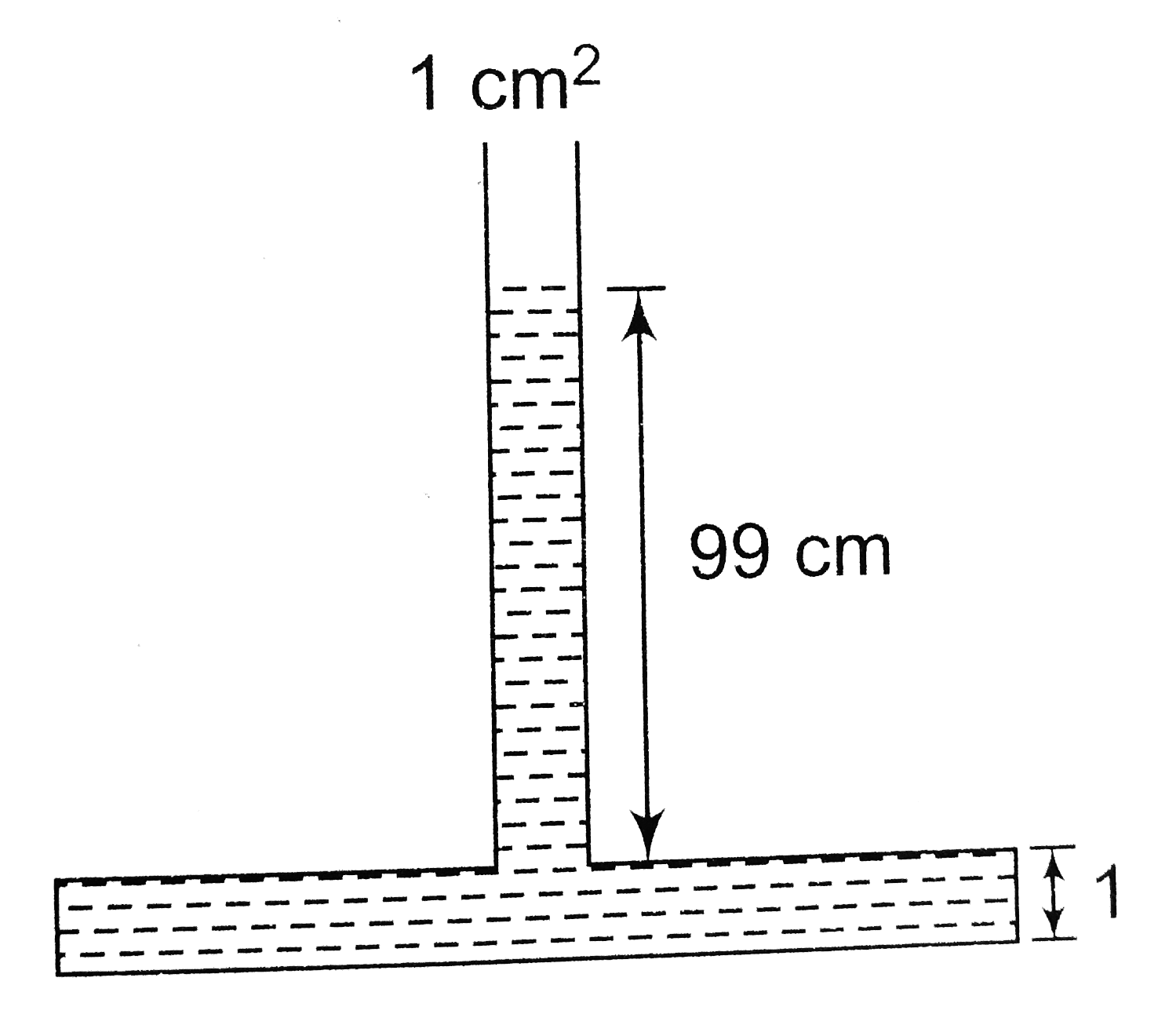An open vessel contains water upto height 50 cm in it. What is the velocity of efflux through an orifice at height 30 cm above the bottom level ? [Take g = 10 m/s2]
To find the velocity of efflux through an orifice in an open vessel containing water, we can use Torricelli's theorem, which states that the velocity of efflux v through an orifice is given by the formula:
v=√2gh
where:
- g is the acceleration due to gravity,
- h is the height of the water column above the orifice.
1. Identify the height of the water column above the orifice:
- The total height of water in the vessel is 50 cm.
- The height of the orifice from the bottom of the vessel is 30 cm.
- Therefore, the height of the water column above the orifice h can be calculated as:
h=Total height of water−Height of orifice=50cm−30cm=20cm
2. Convert the height from centimeters to meters:
- Since the standard unit for height in the formula is meters, we convert 20 cm to meters:
h=20cm=20×10−2m=0.20m
3. Substitute the values into the velocity formula:
- Given g=10m/s2 and h=0.20m, we substitute these values into the formula:
v=√2gh=√2×10m/s2×0.20m
4. Calculate the value inside the square root:
- First, calculate 2×10×0.20:
2×10×0.20=4
5. Find the square root:
- Now, calculate the square root:
v=√4=2m/s
Final Answer:
The velocity of efflux through the orifice is 2m/s.
- g is the acceleration due to gravity,
- h is the height of the water column above the orifice.
- The total height of water in the vessel is 50 cm.
- The height of the orifice from the bottom of the vessel is 30 cm.
- Therefore, the height of the water column above the orifice h can be calculated as:
h=Total height of water−Height of orifice=50cm−30cm=20cm
- Since the standard unit for height in the formula is meters, we convert 20 cm to meters:
h=20cm=20×10−2m=0.20m
- Given g=10m/s2 and h=0.20m, we substitute these values into the formula:
v=√2gh=√2×10m/s2×0.20m
- First, calculate 2×10×0.20:
2×10×0.20=4
- Now, calculate the square root:
v=√4=2m/s
The velocity of efflux through the orifice is 2m/s.
Topper's Solved these Questions
- MECHANICAL PROPERTIES OF FLUIDSBook:AAKASH INSTITUTE ENGLISHChapter:MECHANICAL PROPERTIES OF FLUIDSExercise:SECTION - A
Explore 50 Videos
- MECHANICAL PROPERTIES OF FLUIDSBook:AAKASH INSTITUTE ENGLISHChapter:MECHANICAL PROPERTIES OF FLUIDSExercise:SECTION - B
Explore 23 Videos
- MECHANICAL PROPERTIES OF FLUIDSBook:AAKASH INSTITUTE ENGLISHChapter:MECHANICAL PROPERTIES OF FLUIDSExercise:SECTION - J
Explore 9 Videos
- MAGNETISM AND MATTER Book:AAKASH INSTITUTE ENGLISHChapter:MAGNETISM AND MATTER Exercise:ASSIGNMENT (SECTION D)
Explore 26 Videos
- MECHANICAL PROPERTIES OF SOLIDSBook:AAKASH INSTITUTE ENGLISHChapter:MECHANICAL PROPERTIES OF SOLIDSExercise:Assignment(Section-D)
Explore 14 Videos
Similar Questions
A container filled with a liquid of density 4p as shown in the figure. The velocity efflux through orifice is (ρ is density of water and g = 10 ms−2)
_PHY_E05_013_Q01.png)
View SolutionThe velocity of efflux of a fluid through an orifice 15 cm below the fluid surface (which is open to the atmosphere) is [Take g = 10 m s−2]
View Solution
Knowledge Check
A cylinder of height 20 m is completely filled with water. The velocity of efflux of water through a hole on the side wall of the cylinder near its bottom is (Take g=10ms−2)
A10ms−1B20ms−1C25.5 m s−1D5ms−1
A area of cross section of a large tank is 0.5m2. It has an opening near the bottom having area of cross section 1cm2. A load of 20 kg is applied on the water at the top. Find the velocity of the water coming out of the opening at the time when the height of water level is 50 cm above the bottom. Take g=10ms−2
View SolutionA area of cross section of a large tank is 0.5m2. It has an opening near the bottom having area of cross section 1cm2. A load of 20 kg is applied on the water at the top. Find the velocity of the water coming out of the opening at the time when the height of water level is 50 cm above the bottom. Take g=10ms−2
View SolutionA body is thrown vertically upward from a point A 125 m above the ground. It goes up to a maximum height of 250 m above the ground and passes through A on its downward journey. The velocity of the body when it is at a height of 70 m above the ground is (g=10m/s2)
View SolutionAn open vessel containing the liquid upto a height of 15 m. A small hole is made at height of 10 m from the base of the vessel then the initial velocity of efflux is (g = 10 m/s2)
View SolutionA tube 1cm2 in cross- section is attached to the top of a vessel 1 cm high and of cross - section 100 cm2 Water is poured into the system filling it to a depth of 100 cm above the bottom of the vessel as shown in fig. Take g =10 ms−2 .

View SolutionA tube 1cm2 in cross- section is attached to the top of a vessel 1 cm high and of cross - section 100 cm2 Water is poured into the system filling it to a depth of 100 cm above the bottom of the vessel as shown in fig. Take g =10 ms−2 .

View SolutionA large cylindrical vessel contains water to a height of 10 m. If is found that the thrust acting on the curved surface is equal to that at the bottom. If atmospheric pressure can support a water column of 10 m. the radius of the vessel is
View Solution

